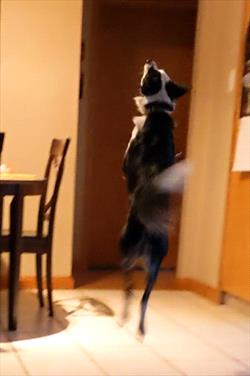Compulsive and repetitive behaviors are a variation of normal behaviors such as eating, walking or self-grooming. The behaviors may appear out of context in a repetitive, exaggerated, or ritualistic way. These are commonly observed in species of animals housed in zoos but can occur in horses, farm animals, dogs, cats, and small mammals as well.
Common compulsive and repetitive behaviors may include:
- movement: spinning, tail–chasing, pacing, freezing, jumping in place, skin rippling;
- oral behaviors: self-licking, self-chewing, air or nose licking, flank sucking, wool sucking, fly snapping, polyphagia (eating more), polydipsia (drinking more), psychogenic alopecia (pulling out hair), pica (eating non-nutritional items) chewing and licking objects;
- vocalization: repetitive barking, whining, howling;
- hallucinatory: shadow or light chasing, startling, avoidance, fly snapping, air licking;
- aggressive: self-directed aggression (growling, biting at tail), aggressive behavior directed towards an object.
Dogs and cats of any age, breed, or sex can develop a compulsive or repetitive behavior disorder. The average age of onset is 12-36 months in dogs and 24-48 months in cats. Approximately 50% of animals with compulsive and repetitive behaviors start to show signs before one year of age.
Some breeds are more likely to show these behaviors.
- Bull Terriers: spinning, tail chasing, freezing
- German Shepherds: spinning and tail chasing
- Great Danes and German Short-Haired Pointers: self-mutilation, stereotypical motor behaviors such as fence running, hallucinations
- Dalmatians, Rottweilers, and German Shepherds: hallucinations
- Doberman Pinschers: flank sucking
- Border Collies: staring at shadows
- Australian Cattle Dogs: tail chasing
- Miniature Schnauzers: checking the hind end
There are other risk factors for compulsive behaviors. Living in stressful environments may cause anxiety, conflict, or frustration, predisposing the animal to compulsive behaviors. A previous injury or irritation may trigger the behaviors. In some situations, the behavior might have been accidentally reinforced, resulting in attention-seeking behaviors.
As with all behavior concerns, the first step is to rule out underlying medical conditions. Some common medical diseases that may result in compulsive behaviors include:
- seizures;
- neurological diseases;
- infectious diseases such as Lyme disease or distemper;
- gastrointestinal disorders;
- ophthalmological disease;
- metabolic diseases;
- exposure to a toxic substance;
- skin diseases;
- injuries.
When diagnosing compulsive and repetitive conditions, the first step is a complete physical and neurological examination. Routine blood work and urinalysis can help to determine your pet’s overall health and function of internal organs along with any other diagnostics that your veterinarian may feel is necessary. Video recordings of your pet when you are not there to observe their behavior can help differentiate attention-seeking from compulsive behaviors.
Treating compulsive behaviors is a multi-step process.
-
Manage specific triggers: Treatment starts by avoiding specific triggers for the behavior whenever possible. Turn off the lights or close the blinds to reduce the creation of shadows. Avoid punishment or physically stopping your pet from performing the behavior. Both cause conflict and may result in an increase in anxiety or aggression directed at you.
-
Manage anxiety: Anxiety often contributes to compulsive behaviors, so it is important to treat the anxiety in addition to the compulsive behavior.
-
Avoid reinforcing the behavior and provide distractions instead. Food dispensing and puzzle toys can be great ways to distract your pet to reduce the compulsive behavior.
-
Use positive reinforcement to teach and reinforce alternate behaviors such as coming when called, going to a mat, nose targeting, eye contact, and a chin rest.
-
Make sure your dog’s basic needs are being met with physical activity and mental enrichment to reduce the opportunity for compulsive behaviors to occur.
-
Medications may be needed for the treatment of compulsive behaviors.
Compulsive and repetitive behaviors may require lifelong treatment for your dog. Relapses can occur if they become stressed or experience conflict or frustration. If you have not seen improvement in two to three months or the behavior worsens, your dog should be reevaluated by your veterinarian. Compulsive behaviors are often managed for life, not cured.



